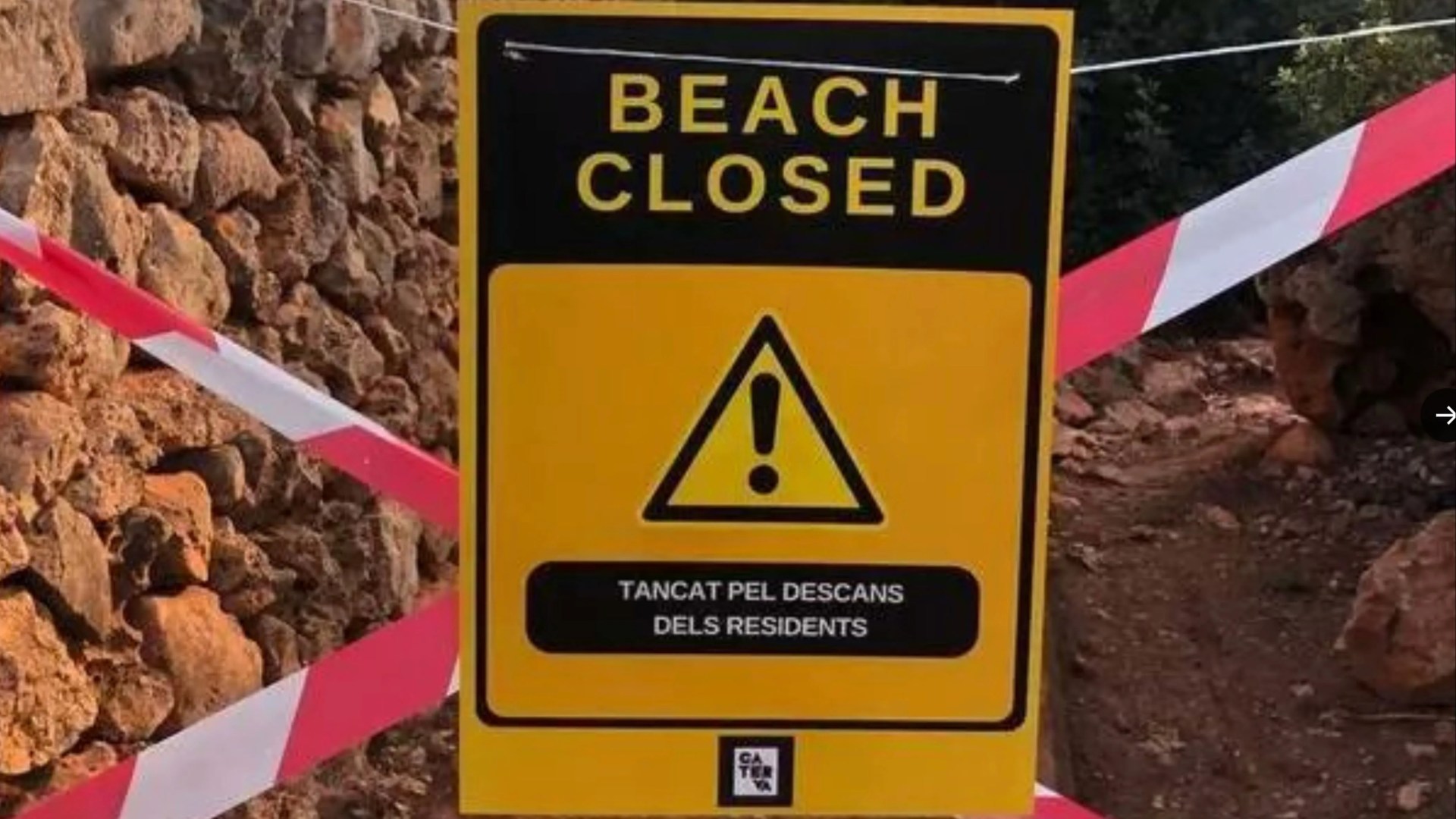MAJORCA’s angry anti-tourist locals have put up fake beach closure signs in a new bid to hold back holidaymakers.
And in a separate action residents of a picture-postcard village caused traffic chaos by walking back and forth across zebra crossings in a half-hour demo to thwart frustrated visitors trying to reach the coast.

8

8

8

8
The separately organised protests, which took place more than 850 miles apart, showed the depth and breadth of the campaigns targeting tourists.
A protest group called Caterva was behind the fake beach closures in Manacor in eastern Majorca on Saturday.
The fed-up group put up red tape and signs at several coves saying “Beach Closed”.
They include the secluded white-sand cove Cala Varques and a “hidden” cove renowned for snorkelling called Cala Petita.
Caterva said in a post on X, formerly Twitter: “New action by Caterva in Manacor. We closed coves for residents’ use and rest. Let’s change course and prioritise life.
“We believe the tourist is part of the machinery and has responsibility for the situation we suffer.”
“But the main people responsible are those who own the hotel chains and construction companies and real estate firms.
“They’re the ones we should be pointing our fingers at.”
The separate zebra crossing protest took place yesterday in the municipality of Cangas do Morrazo, which is dotted with beautiful sandy beaches and stunning clifftop views.
Around 80 locals walked repeatedly back and forth across the village’s three crossings in front of stunned motorists, who were forced to sit in their cars waiting for them to finish.
They carried out the demo to complain about scores of tourists through the region’s 38 beaches and the fact visitors park outside of designated areas.
Some tourists are said to have given up trying to reach the coast, turning around instead.
The protest started around 11.30am on Sunday and continued until around midday.
It was abruptly called off before police could arrive and identify those taking part.
Villager Esperanza Vega said: “Every summer things get worse.”
Mercedes Villar, president of a local neighbourhood association, added: “This is not tourism-phobia, it’s the right of residents to leave in peace and it’s about protecting … our security and physical integrity.”
TOURIST TENSION BOILING ACROSS SUNNY SPAIN
In the Majorcan capital Palma, two big protests have this year taken place as locals rage about overcrowding and dwindling affordable housing.
Other smaller protests have taken place elsewhere on the island as well as its Balearic neighbours Menorca, Ibiza and Formentera.
On July 27, around 250 protesters impeded tourist access to a Menorcan beach in a “surprise action”.
Activists boasted of filling a car park by Cala Turqueta, a beautiful cove on the island’s southern coast, with “residents’ cars”.
They then used towels and their own bodies to shape the message “SOS Menorca” on the sand by the waterline.
The unannounced protest, by environmental non-profit organisation GOB Menorca, resulted in the car park being “blocked” to holidaymakers for around six hours from early morning, according to local reports.
Anti-mass-tourism protests have also taken place in the Canary Islands, as well as mainland hotspots like Alicante and Malaga.
On August 18, protesters unfurled a huge banner telling tourists on a packed Costa Blanca beach in Alicante that read: “Go home.”
Graffiti targeted at tourists has appeared in both Tenerife and Majorca.
The activists let off pink flares to make sure holidaymakers relaxing on the sand or cooling off in the sea received the message.
They appeared to be directing themselves at English-speaking visitors with the language they used in bright-red capital letters, although they also used the local Valencian language to appeal to residents with a message above it on the banner which said: “Aturem La Turistificacio” – “Stop Touristification”.
The beach protest was carried out by a group called Garrot and took place close to Benidorm.
The banner was unfurled on rocks to the north of the cove where it was clearly visible to those in the sea and on the beach.
Anti-tourist measures sweeping hotspots
A WAVE of anti-tourist measures are being implemented across Europe to curb mass tourism in popular holiday hotspots.
Overcrowding has become the main problem in many sunny destinations, with authorities trying to find a solution to keep tourists and locals happy.
Officials have attempted to reduce the impact of holidaymakers by implementing additional taxes on tourists, or banning new hotels.
Earlier this year Venice became the first city in the world to charge an entry fee for holidaymakers after it started charging day-trippers €5 (£4.30) if visiting the historical Italian centre.
It was followed by an area in Barcelona which resorted to removing a well-used bus route from Apple and Google Maps to stop crowds of tourists from using the bus.
Meanwhile, San Sebastián in the north of Spain, limited the maximum number of people on guided visits to 25 to avoid congestion, noise, nuisance and overcrowding.
The city has already banned the construction of new hotels.
The Spanish government has allowed restaurants to charge customers more for sitting in the shade in Andalucia.
Benidorm has introduced time restrictions, as swimming in the sea between midnight and 7am could cost a whopping £1,000.
The Canary Islands are also considering adopting measures to regulate the number of visitors – and charge tourists a daily tax.
Greece has already enforced a tourist tax during the high season (from March to October) with visitors expected to pay from €1 (£0.86) to €4 (£3.45) per night, depending on the booked accommodation.
Officials in Santiago de Compostela in Galicia want to introduce a fee for travellers to remind people to be courteous during their trips.

8

8

8

8




